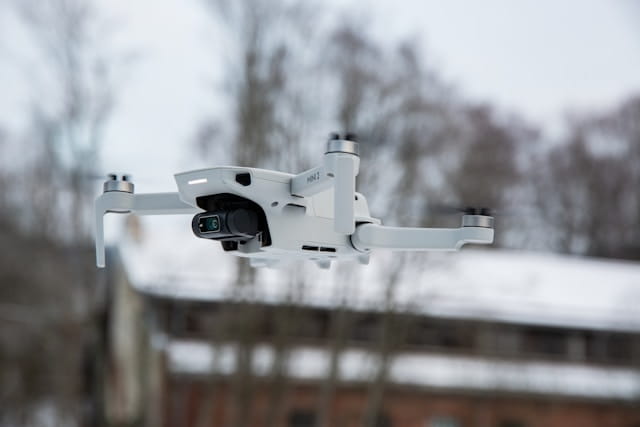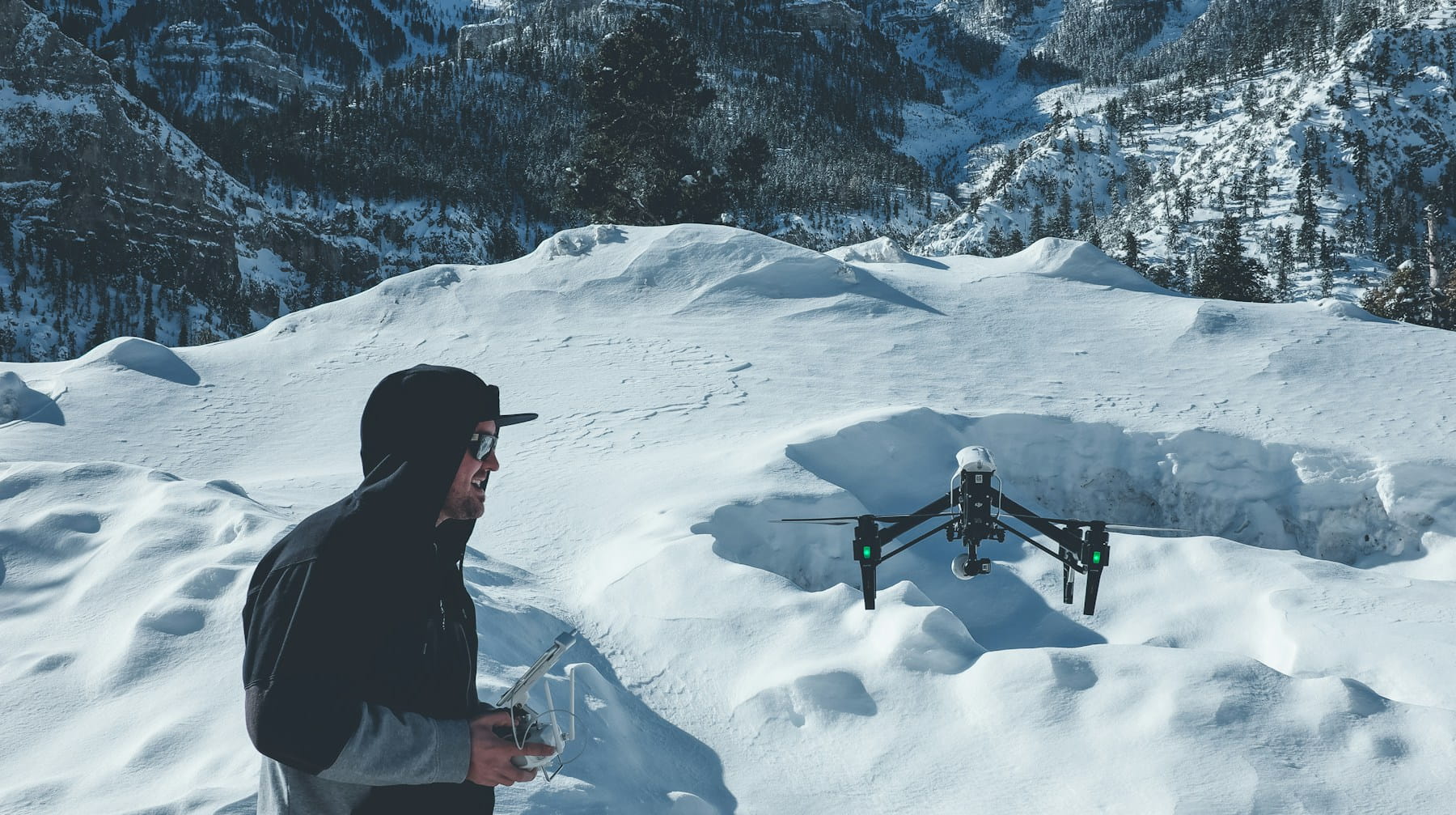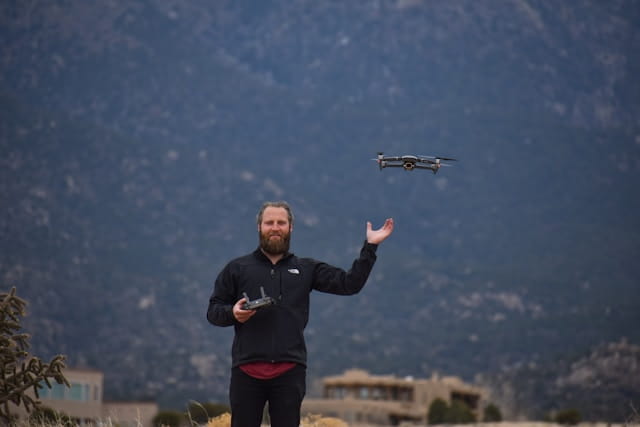Visual Line of Sight is essential for safe drone operations, requiring direct visual contact, proper equipment, and environmental awareness to ensure regulatory compliance and operational safety across various industries.
Drone pilots face a fundamental operational requirement that shapes every aspect of flight planning and execution. Visual Line of Sight (VLOS) represents more than just a regulatory checkbox—it forms the backbone of safe unmanned aircraft operations worldwide.
The concept seems straightforward enough. Keep your drone where you can see it. But the reality of VLOS operations involves layers of complexity that affect everything from mission planning to equipment selection. Professional drone operators quickly learn that mastering VLOS isn't just about compliance; it's about building operational excellence.
Table of contents
- Understanding visual line of sight requirements
- Regulatory framework and compliance
- VLOS vs BVLOS: Key operational differences
- Factors affecting visual line of sight
- Industry applications and use cases
- Equipment considerations for VLOS operations
- Operational challenges and solutions
- Safety protocols and best practices
- Future developments and regulatory evolution
- Maximizing VLOS operational efficiency
Understanding visual line of sight requirements
Visual Line of Sight operates on a deceptively simple principle: drone operators must maintain direct visual contact with their aircraft throughout the entire flight. This direct visual contact serves multiple critical functions that extend far beyond basic regulatory compliance.
The operator's eyes become the primary safety system during VLOS operations. Unlike manned aircraft with onboard pilots who can see and avoid obstacles, unmanned systems rely entirely on the remote pilot's visual assessment of the airspace. This responsibility places significant demands on operator attention and situational awareness.
But what exactly constitutes "visual contact"? The definition varies slightly between regulatory bodies, but most authorities require that operators can see the aircraft well enough to determine its location, altitude, attitude, and direction of flight. Some regulators specify that operators must be able to see the aircraft with unaided vision—meaning no binoculars or telescopes.
The visual requirements become more stringent when considering the need to spot and avoid other aircraft. Pilots must not only track their own drone but also scan the surrounding airspace for potential conflicts. This dual responsibility of aircraft control and collision avoidance makes VLOS operations mentally demanding.
Weather conditions play a massive role in VLOS effectiveness. What constitutes adequate visual contact on a clear day might become impossible during haze, fog, or precipitation. Smart operators develop weather minimums that exceed regulatory requirements, recognizing that legal visibility might not always translate to safe visibility.
Distance limitations naturally emerge from visual requirements. Most small drones become difficult to see and control beyond 1,000 to 1,500 feet, depending on aircraft size and environmental conditions. Professional operators often establish personal maximums well below these distances to maintain positive control.
Regulatory framework and compliance
Aviation authorities worldwide have established VLOS as the foundation for civilian drone operations. The Federal Aviation Administration (FAA) in the United States, the European Union Aviation Safety Agency (EASA), and Transport Canada all mandate VLOS for most commercial drone operations.
Under FAA regulations, Part 107 operations require the remote pilot in command to maintain VLOS of the unmanned aircraft. The regulation doesn't specify exact distance limitations but requires that the pilot can see the aircraft sufficiently to perform the duties required for safe operation.
Visual observers can extend VLOS operations under specific conditions. These trained individuals must maintain direct communication with the pilot and provide additional eyes for airspace monitoring. However, visual observers don't simply double the operational range—they must still maintain the same visual standards as the primary pilot.
Regulatory violations related to VLOS carry serious consequences. The FAA has issued substantial fines for operators who flew beyond visual range without proper authorization. Understanding comprehensive compliance requirements ensures all regulatory obligations are met. These enforcement actions demonstrate that regulators take VLOS requirements seriously and actively monitor compliance.
International variations in VLOS regulations create challenges for operators working across borders. While the core concept remains consistent, specific requirements for visual observers, distance limitations, and altitude restrictions can vary significantly between countries.
VLOS vs BVLOS: Key operational differences
Beyond Visual Line of Sight (BVLOS) operations represent the next evolution in drone capabilities, but the regulatory path remains complex and expensive. Understanding the differences between VLOS and BVLOS helps operators make informed decisions about their operational approach.
VLOS operations require minimal additional equipment beyond basic drone systems. Pilots rely on direct visual contact and standard communication links to maintain safe operations. This simplicity translates to lower costs and faster deployment for many applications.
BVLOS operations, by contrast, require sophisticated detect-and-avoid systems, enhanced communication links, and often ground-based radar or other surveillance equipment. These requirements can increase operational costs by tens of thousands of dollars per deployment.
The following table illustrates key differences between VLOS and BVLOS operations:
| Aspect | VLOS Operations | BVLOS Operations |
|---|---|---|
| Visual contact requirement | Direct visual contact required | Visual contact not required |
| Equipment complexity | Basic drone systems | Advanced detect-and-avoid systems |
| Regulatory approval | Standard Part 107 or equivalent | Special authorization required |
| Operational range | Limited to visual range (~1-2 miles) | Extended range capability |
| Cost considerations | Lower operational costs | Significantly higher costs |
| Deployment speed | Rapid deployment | Extended planning and approval |
The regulatory approval process for BVLOS operations involves extensive documentation, risk assessments, and often requires months or years to complete. Many operators find that VLOS operations provide sufficient capability for their missions while avoiding the complexity of BVLOS approvals.
Factors affecting visual line of sight
Environmental conditions dramatically impact VLOS effectiveness. Atmospheric visibility, lighting conditions, and weather patterns all influence how far and how clearly operators can see their aircraft.
Haze represents one of the most challenging conditions for VLOS operations. Unlike fog, which obviously impairs visibility, haze can create deceptive conditions where objects appear visible but lack the contrast needed for proper aircraft control. Many operators learn this lesson the hard way when their drone seemingly vanishes into gray atmospheric soup.
Aircraft design significantly affects visual detectability. Larger drones remain visible at greater distances, while smaller consumer drones can become nearly invisible beyond a few hundred feet. Color schemes matter too—high-contrast colors like white or bright orange maintain visibility better than earth tones or dark colors.
Lighting conditions create dynamic challenges throughout the day. Early morning and late afternoon operations often provide excellent visibility, while midday sun can create challenging backlighting situations. Night operations require special lighting systems and typically operate under different regulatory frameworks.
Background conditions influence aircraft visibility more than many operators realize. A white drone against a cloudy sky becomes nearly invisible, while the same aircraft stands out clearly against a dark treeline. Experienced pilots constantly assess background conditions and adjust their operations accordingly.
Operator fatigue affects visual performance in ways that pilots don't always recognize. Extended operations can reduce visual acuity and reaction times, potentially compromising safety even when environmental conditions remain good.
Industry applications and use cases
VLOS operations support a tremendous range of commercial applications, each with unique operational requirements and challenges. Professional operators have developed specialized techniques for maximizing VLOS effectiveness within their specific industries.
Construction and infrastructure inspection represent major VLOS application areas. These operations typically involve detailed visual inspection of structures, requiring operators to maintain close proximity to their target while navigating complex environments with cranes, buildings, and other obstacles.
Agricultural applications often push VLOS distance limitations to their maximum extent. Crop monitoring and precision agriculture operations benefit from covering large areas, but operators must balance efficiency with regulatory compliance and safety requirements.
Real estate and media production rely heavily on VLOS operations for aerial photography and videography. These applications typically require precise aircraft positioning and smooth flight paths, placing premium value on maintaining positive visual control throughout the mission.
Emergency response and public safety operations face unique VLOS challenges. Time-sensitive situations may pressure operators to extend beyond comfortable visual ranges, requiring strong operational discipline and clear safety protocols.
Search and rescue missions often involve VLOS operations in challenging terrain and weather conditions. Operators must balance the urgent need for area coverage with the fundamental safety requirements of maintaining visual contact.
Environmental monitoring applications frequently involve VLOS operations in remote locations with challenging logistics. Operators must plan for extended operations while maintaining visual contact requirements and managing equipment power limitations.
Equipment considerations for VLOS operations
Aircraft selection profoundly impacts VLOS operational effectiveness. Larger platforms remain visible at greater distances but may face increased regulatory scrutiny and operational complexity. Smaller platforms offer deployment advantages but limit operational range and payload capacity.
Visual enhancement equipment can extend effective VLOS range within regulatory constraints. High-quality sunglasses, anti-glare visors, and prescription eyewear corrections all contribute to maintaining visual contact at maximum distances.
Communication systems become critical during extended VLOS operations, particularly when working with visual observers or ground support teams. Reliable radio communications prevent dangerous situations where team members lose coordination during flight operations.
Aircraft lighting systems can significantly improve visibility during marginal conditions. LED strobe lights, navigation lights, and high-contrast paint schemes all contribute to maintaining visual contact. Some operators install custom lighting systems that exceed regulatory minimums for enhanced safety margins.
Ground control stations with high-resolution displays provide backup situational awareness during VLOS operations. While these systems don't replace visual contact requirements, they offer valuable supplementary information about aircraft status and position.
Backup equipment considerations become important during professional VLOS operations. Equipment failures during commercial missions can result in significant costs and schedule disruptions. Professional operators typically carry backup aircraft, batteries, and control systems.
Operational challenges and solutions
Distance management represents one of the most common VLOS operational challenges. Operators must constantly balance mission effectiveness with regulatory compliance and safety requirements. Successful professionals develop techniques for maximizing coverage while maintaining visual contact.
Airspace complexity creates significant challenges in urban and industrial environments. Operators must maintain visual contact while navigating around buildings, towers, and other obstacles that can block line of sight. Pre-flight planning becomes critical for identifying potential visual obstruction areas.
Team coordination challenges emerge when working with visual observers, ground crews, or multiple aircraft. Clear communication protocols and defined responsibilities help prevent dangerous situations where team members have conflicting situational awareness.
Weather decision-making requires operators to make real-time assessments of changing conditions. Visibility can deteriorate rapidly during weather transitions, potentially stranding aircraft beyond visual range. Conservative weather minimums and abort criteria help maintain safety margins.
Client expectations sometimes conflict with VLOS operational limitations. Commercial operators frequently face pressure to extend beyond visual range to capture specific shots or complete mission objectives. Professional operators must educate clients about regulatory requirements and safety limitations.
Fatigue management becomes critical during extended VLOS operations. Maintaining constant visual attention for hours at a time can be mentally exhausting. Smart operators plan breaks, rotate responsibilities, and recognize signs of degraded performance.
Safety protocols and best practices
Pre-flight planning forms the foundation of safe VLOS operations. Implementing systematic pre-flight procedures ensures mission success while maintaining regulatory compliance. Operators should identify potential visual obstruction areas, establish abort criteria for weather conditions, and plan flight paths that maximize visual contact opportunities.
Visual scan patterns help operators maintain consistent airspace awareness during flight operations. Systematic scanning techniques ensure that pilots don't fixate on the aircraft while missing other important airspace users or hazards.
Communication protocols become essential when working with teams or in controlled airspace. Clear, standardized radio procedures help maintain situational awareness and prevent miscommunication during critical phases of flight.
Emergency procedures must account for VLOS limitations. Operators should practice scenarios where visual contact is lost and develop immediate response procedures that prioritize safety over mission completion.
Documentation and record-keeping support safety culture and regulatory compliance. Professional operators maintain detailed logs of weather conditions, operational limitations, and any safety-related events that occur during VLOS operations.
Regular training and proficiency maintenance help operators stay sharp and current with best practices. Professional pilot training programs provide structured approaches to developing and maintaining VLOS competency. VLOS skills can deteriorate without regular practice, particularly the ability to maintain visual contact in challenging conditions.
Future developments and regulatory evolution
Regulatory authorities worldwide are working to expand BVLOS capabilities while maintaining safety standards. These developments will gradually reduce reliance on VLOS for certain applications, but visual line of sight will remain important for many operations.
Technology integration is making VLOS operations more effective and safer. Advanced flight control systems, improved cameras, and better communication links all contribute to enhanced VLOS capabilities without requiring regulatory approval.
Industry standardization efforts are developing best practices for VLOS operations across different application areas. These standards help establish consistent safety cultures and operational procedures that benefit the entire drone industry.
Training program development continues to evolve as the industry gains experience with VLOS operations. Better training resources and standardized curricula help new operators develop strong VLOS skills and safety habits.
International harmonization efforts aim to reduce regulatory complexity for operators working across borders. Consistent VLOS requirements would significantly simplify international drone operations and equipment certification.
Maximizing VLOS operational efficiency
Strategic flight planning can dramatically improve VLOS operational effectiveness. Operators who understand how to optimize flight paths, timing, and positioning can accomplish significantly more within visual range limitations.
Equipment optimization involves selecting the right combination of aircraft, sensors, and support equipment for specific VLOS missions. This optimization process requires balancing performance requirements with visual detectability and operational complexity.
Team training and coordination procedures help multi-person operations function smoothly within VLOS constraints. Well-trained teams can accomplish complex missions safely while maintaining regulatory compliance and operational effectiveness.
Client education plays a crucial role in successful VLOS operations. Clients who understand the operational constraints and safety requirements become partners in mission success rather than sources of pressure to compromise safety standards.
Continuous improvement processes help operators refine their VLOS techniques and procedures over time. Regular debriefings, safety reviews, and skills assessment contribute to enhanced operational effectiveness and safety performance.
Implementation Considerations
VLOS operations require careful planning that addresses environmental conditions, equipment limitations, and regulatory requirements. Organizations implementing drone programs benefit from understanding visibility factors, safety protocols, and operational best practices before deployment.
Successful VLOS programs often start with comprehensive training that develops both technical skills and safety habits. Professional pilot training and systematic pre-flight procedures ensure consistent operations while maintaining regulatory compliance.
In Summary
The foundation of professional drone operations rests on mastering visual line of sight requirements. VLOS represents more than regulatory compliance—it forms the cornerstone of safe unmanned aircraft operations across all commercial applications.
Operators who develop strong VLOS skills and safety habits create the basis for expanding into more complex operations while maintaining exemplary safety records. This expertise becomes increasingly valuable as the industry grows and regulatory frameworks continue evolving.
The commitment to excellence in VLOS operations separates professional drone services from amateur efforts. This commitment involves ongoing training, equipment investment, and operational discipline that ultimately defines successful drone businesses and contributes to the industry's continued growth and acceptance.
Ready to Enhance Your VLOS Operations?
Join professional pilots who have mastered visual line of sight operations through advanced training systems and comprehensive operational management. Whether you're conducting commercial inspections, emergency response missions, or specialized applications, strong VLOS foundations enable safe and compliant operations.
Start your free trial today — no credit card required. Or book a demo to see how DroneBundle integrates VLOS workflows with compliance management, pre-flight procedures, and pilot training tracking in a platform designed specifically for professional drone operations.




